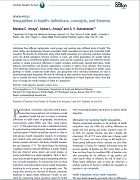Inequalities in health: Definitions, concepts and theories
This review article seeks to “create a centralized resource for understanding methodological, theoretical, and philosophical aspects of health inequalities research” while highlighting previously under-discussed aspects of health disparities research, such as the distinction between measuring disparities by two different geographic parameters of space and place. The authors begin by making the important distinction between unavoidable health inequalities (the differences amongst individuals or groups) and health inequities that denote unjust, preventable, and systemic differences in health.
Next, the article introduces key concepts for gathering and interpreting information on health inequalities and the parameters by which health inequalities are commonly examined within and between populations, including: group-level differences versus overall health distribution; social group health inequalities and the difficulties of defining groups; absolute versus relative social position (particularly important when considering poverty’s impact on health); geographic health inequalities of both space and place; and the complexities of tracking and reporting health inequalities throughout the life course. This discussion then broadens into frameworks and theories for understanding health inequalities and the causal mechanisms and conditional health effects that link geographic and social factors to health.
The article concludes by asking a series of contextual and ethical questions on designing, executing, and using research of health inequalities to best set priorities, benchmarks, and corresponding policy agendas to address health inequalities.
Use this resource to:
- Strengthen your understanding of the core measurement and assessment concepts associated with health equality research
- Improve your ability to critically assess population health status reports and research findings associated with health equity outcomes
- Integrate health equity measures into your program planning and evaluation approaches
Reference:
Arcaya, MC, Arcaya, AL, Subramanian, SV (2015). Review Article. Inequalities in health: definitions, concepts and theories. Global Health Action, 8: 27106. Accessed: http://www.globalhealthaction.net/index.php/gha/article/view/27106
Link where full text can be located (English):
http://www.globalhealthaction.net/index.php/gha/article/view/27106
Link where full text can be located (French):
Available in English only
Related Documents:
- Population health status reporting: the learning together series (2012). https://nccdh.ca/learn//entry/population-health-status-reporting
- The Public Health Observatory handbook of health inequalities measurement (2005). https://nccdh.ca/learn//entry/the-public-health-observatory-handbook-of-health-inequalities-measurement
- Promoting health equity – Choosing appropriate indicators: literature scan (2013). https://nccdh.ca/learn//entry/promoting-health-equity-choosing-appropriate-indicators-literature-scan
- Reducing gaps: using area-based socio-economic measures to explore population health – online course (2012). https://nccdh.ca/learn//entry/reducing-gaps-online-course
- Une stratégie et des indicateurs pour la surveillance des inégalités sociales de santé au Québec (2013). French only: https://nccdh.ca/learn//entry/une-strategie-et-des-indicateurs-pour-la-surveillance-des-inegalites-social
